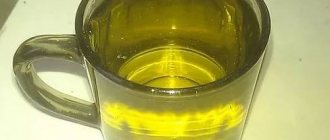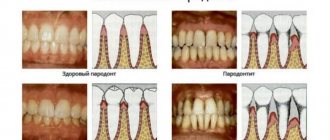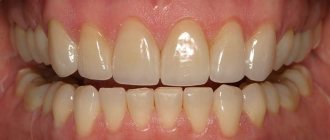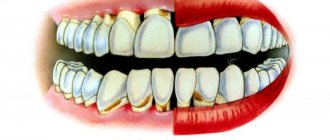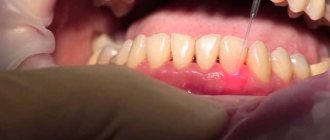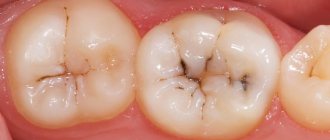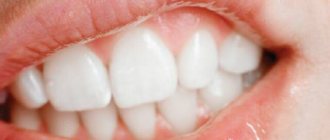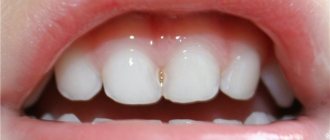Compound
Aloe pulp and juice contain many useful microelements. Due to this, the plant is widely used in traditional medicine. The possibility of using aloe for gums is determined by the following characteristics:
- Vitamin C supplies gums with micronutrients and strengthens capillaries.
- B vitamins: B1, B2, B6 and B12 promote mucosal healing.
- Vitamin E promotes effective tissue regeneration.
- It is no coincidence that folic acid helps protect against gingivitis and periodontitis. Medicines with this ingredient are used in combination with other drugs to eliminate inflammation.
- Vitamin A prevents bleeding and the formation of ulcers.
- Calcium improves blood clotting and strengthens jaw bones.
- Zinc reduces inflammation, disinfects gums, and strengthens periodontal tissue.
- Beta-sitosterol reduces inflammation, eliminates dyspepsia, which causes bad odor, if you take aloe juice internally.
The plant is famous for the fact that it effectively kills bacteria and microbes, speeds up the healing process of tissues, makes them softer, and enriches them with all necessary microelements.
Due to its properties, aloe is widely used in the medical industry. For example, to quickly treat periodontal disease, the patient is prescribed injections of plant juice into the gums. Injections are performed 3-4 times a week for a month. If the periodontal structures are seriously altered, this method is fruitful.
Domestic use
Bleeding and pain in the gums indicate the development of gingivitis. This disease is caused by poor hygiene, poor cleaning, and accumulation of plaque and tartar. You should not diagnose yourself; it is better to consult a dentist who will give an accurate answer.
Aloe does not help against all diseases; the plant effectively relieves symptoms . Therefore, you cannot refuse to go to the dental clinic. If you ignore the problem or self-medicate, for example, using traditional methods, you will not be able to cure gingivitis, and the disease may worsen. This leads to the development of a serious disease - periodontitis.
Contraindications
Treatment with traditional methods requires precautions. Side effects occur with an overdose; if more than 300 mg of agave is ingested, diarrhea is observed. There are a number of contraindications for treating gums with aloe:
- individual intolerance;
- taking diuretics;
- during pregnancy.
We recommend: Aloe for psoriasis - folk recipes
If your gums are bleeding or painful, you should consult a dentist. After identifying the cause of the pathological process, the specialist will prescribe the optimal treatment. In case of accumulation of bacteria, stone formation, inflammation, agave will only reduce discomfort.
The doctor will prescribe complex therapy, in addition to procedures and medications, aloe is also used. At home, when symptoms increase, you should not get carried away with self-medication, which can only aggravate the condition and provoke a severe course of the disease.
Aloe for treating gums?
There are various ways to use this plant for medicinal purposes. The simplest option for relieving pain and swelling of the gums is a regular aloe compress on the gums. But the effect largely depends on the type of plant and the nature of the symptoms. The gel and juice obtained from the leaves of the plant are widely used in traditional medicine.
First, you need to cut off the skin from the leaves of the agave, after thoroughly washing them under running tap water. Place a piece of aloe vera on the inflamed area. You can apply the plant to the mucous membrane for a long time, but side effects are possible. Therefore, an experiment should be conducted to test its reaction to the plant sap.
To treat periodontal disease, apply compresses from agave leaves at night. The course of therapy includes 10 applications of such a compress, which should be carried out daily.
When treating inflamed gums and stomatitis, it is possible to use freshly squeezed aloe juice as a gargle. Obtaining such juice is quite simple and possible in several ways from the leaves of the plant. You can use a meat grinder or blender to grind the leaves. In the first example, after processing, it is necessary to pass the pulp through cheesecloth. If you use a blender, you can remove the remaining leaves by hand.
You need to rinse your mouth 2 times a day until the symptoms subside. When rinsing, you should not swallow the juice, but simply spit it out.
It is advisable to use freshly prepared juice before each rinse. If you don't have time to prepare, you can stock up. A glass jar placed in a place inaccessible to light is suitable for storage.
Aloe gel is great for compresses . To get it, you just need to cut the agave leaf lengthwise and then collect the mucus that has been released.
Treatment with medications
For the treatment of inflamed gums, solutions, gels and ointments are used that have analgesic, anti-inflammatory and antimicrobial effects, promote the healing of microtraumas and protect tissue.
Table. Mouth rinses.
NameDescriptionMethod of application
| "Listerine" | Antibacterial agent designed to eliminate symptoms of dental diseases | Rinse your mouth twice a day after hygiene procedures, do not dilute with water. |
| "Stomatofit" | Concentrated solution of medicinal herbs, which includes extracts of various plants and other components | Dilute 10 ml of the drug in half a glass of water, apply 3-4 times a day |
| "Chlorhexidine" | An effective antiseptic that cleanses mucous membranes well and fights inflammatory processes. | Use as a mouth rinse every time after a meal. |
| "Miramistin" | A drug with a pronounced antibacterial effect, effective against most microorganisms that cause gum inflammation | Rinse your mouth 3-4 times a day or wipe the affected areas with a cotton swab dipped in the solution |
| "Rotokan" | A product with a local anti-inflammatory effect, promotes tissue regeneration and reduces bleeding | Dissolve the drug (a teaspoon) in 250 ml of warm boiled water, use 2-3 times a day, the course of treatment is 2-5 days |
| "Malavit" | Homeopathic remedy with antimicrobial and decongestant action | Take 10 drops of solution per glass of warm water, rinse daily for a week |
| "Forest Balm" | Mouth rinse containing tea tree oil, aloe and pine extracts | Use every time after meals until the unpleasant symptoms disappear (can be used for preventive purposes) |
Rinse solutions are recommended to be used in combination with gels and ointments, which not only eliminate the unpleasant symptoms of the disease, but also form a protective film on the surface of the gums that prevents the entry of bacteria.
Mouth rinse
Table. Therapeutic gels and ointments.
NameDescriptionMethod of application
| "Periodonticide" | Dental gel containing extracts of sage, mint, cloves, oregano and other anti-inflammatory and disinfecting components | Lubricate the gums 2-3 times a day for no more than 10 days in a row |
| "Gengigel" | A medicine that contains hyaluronic acid. Used to eliminate manifestations of gum inflammation, tissue regeneration and eliminate harmful microorganisms | Apply to inflamed tissues 3-4 times a day until symptoms are completely eliminated |
| "Holisal" | Gel with anti-inflammatory and antimicrobial effect, as well as instant pain relief | Rub into affected areas 2-3 times a day for 5-7 days |
| "Asepta" | Balm with propolis, which promotes tissue regeneration and eliminates bleeding | Use 2-3 times a day for 7-14 days |
| "Dentol" | Local anesthetic with rapid action and regenerating effect | Apply to the surface of the gums 3-4 times a day for no more than 7 days in a row. |
We invite you to familiarize yourself with the causes of saliva foaming in the mouth - Thick, viscous and viscous saliva in the mouth: causes of thick saliva, treatment - Medicine in photographs
It should be noted that most dental solutions, gels and ointments have a number of contraindications - in particular, they are not used during pregnancy, inclination to allergic reactions, as well as for the treatment of diseases in children.
In advanced cases (with deep damage to the gums), patients need treatment with antibiotics, but the decision to prescribe them can only be made by a doctor. Most often, for dental diseases, broad-spectrum antimicrobial drugs are used (Lincomycin, Glycosamide), which do not cause side effects and are well tolerated by the body.
"Lincomycin"
If you have gum inflammation, it is better to brush your teeth with special pastes that have an anti-inflammatory and protective effect - “Paradontax”, “President”, “Lakalut”. You can use such pastes for a month, after which you need to take a break.
"Paradontax"
What vegetation is good for the oral cavity?
Yarrow juice can be used in the initial stages of periodontitis and gingivitis. These diseases begin to appear when the gums are damaged by mechanical action, if teeth grow incorrectly and there is no proper oral hygiene.
The recipe for preparing a rinse solution is simple . Add 3-5 drops of yarrow juice to a glass of clean warm water and stir. The solution is ready for rinsing the mouth. After regular use you will achieve positive results.
Yarrow can be used for treatment in the form of compresses, as an addition to rinsing. To prepare, take a thick yarrow leaf, cut it and collect the medicinal mucus of the plant in a container. Roll up a piece of gauze in several layers, apply the collected gel-like juice to it and apply to the gum affected by the disease for 30 minutes. Compresses can be used for gum inflammation, bleeding, stomatitis, or loose teeth.
Herbal infusion recipes
There is no point in preparing a lot of rinse liquid. Focus on 180-250 ml, consume this volume in 2-3 rinses. Alternate herbs and herbal infusions, mix them with each other when brewing, make the procedures varied.
Traditional medicine recommends for 1 glass of boiling water:
- thyme 2 tbsp. l. – steam, leave for 20 minutes, strain;
- calendula flowers 20-25 g;
- 4 tbsp. spoons of chamomile flowers, leave for 20 minutes, strain;
- Brew birch buds in a 1:1 ratio, hold in a water bath for 15 minutes, strain and apply;
- golden mustache suppresses inflammation well and strengthens gums, chop 1 medium-sized leaf, pour boiling water, leave for half an hour, rinse your mouth in the morning;
- oak bark - 25 g of dry mixture after brewing, keep on low heat for 30-40 minutes, strain, add an equal volume of boiled water, use intensively for chronic and advanced gingivitis (a very powerful remedy);
- alder cones 2 tbsp. l.;
- St. John's wort, sage, celandine - 2 tbsp.
l. one item or a mixture of them. Rinsing your mouth with oak bark to strengthen your gums and teeth
Other rinses:
- aloe leaves - grind a shoot 15-20 cm long to obtain juice, mix with 0.5 cups of warm water;
- mumiyo - 2.5 g per 125 ml of warm water;
- ½ tsp. baking soda and ¼ tsp. salt, 1 glass of boiled water;
- ½ tsp. dried crushed ginger in 0.5 cups of warm water - rinse your mouth 1-2 times daily, the product works as an antibiotic;
- mumiyo – ¼ tsp. dilute with hot water, add warm water to 75-100 ml, use separately or with any herbal decoction.
- freshly squeezed carrot or cabbage juice (mix with boiled water in equal parts);
- tea tree essential oil quickly suppresses the growth of bacteria, strengthens local mucosal immunity, use 1-2 drops in half a glass of hot water, cool until the sensation is tolerable and rinse your mouth 1-2 times a day;
- garlic (a powerful natural antibiotic), crush, add 4 parts of water to 1 part of the resulting pulp, stir, squeeze out after half an hour, rinse your mouth 3 times a day.
We suggest you familiarize yourself with the best antibiotics for toothache and inflammation of the nerve or gums
Aloe
In the aloe plant, the most valuable is acemanan, a carbohydrate from the mucopolysaccharide group. For metabolic processes, the main essential nutrients are carbohydrates. An adult gets acemanan only through food, since it is produced independently before puberty. Ginseng also contains acemanan.
Treatment with aloe juice must be carried out with caution. In advanced stages of oral diseases, this remedy provokes complications. Treatment using traditional recipes can reduce pain and alleviate the patient’s condition, but cannot eliminate the inflammatory process.
If patients are taking medication, it is prohibited to eliminate the inflammatory process in the oral cavity with aloe juice. It has been proven that the effectiveness of the effects of drugs is reduced due to the beneficial composition of the plant.
The use of medicinal decoctions, tinctures and aloe juice is prohibited for people susceptible to allergic reactions to the plant and for patients who suffer from inflammatory processes. If discomfort occurs, or itching or various allergic reactions occur, the use of aloe should be stopped immediately.
Pregnant women are not recommended to use the plant ; its juice increases uterine tone and can lead to termination of pregnancy.
Pharmacy products containing aloe
The pharmaceutical business has long turned its attention to the medicinal properties of agave.
And now in pharmacies you can find all kinds of tinctures and preparations containing aloe. They are used to treat various diseases, as well as as a preventive measure. These drugs are used in the following form:
- As lozenges.
- In the form of an extract in ampoules for injections (read about other ways to effectively use aloe extract here).
- Juice in bottles for internal use.
- Syrup with iron.
- In the form of throat sprays (Aqualor throat, Aloe First).
Side effects when taking aloe
Despite the fact that aloe juice is used to treat the oral cavity, it has an effect on the entire body as a whole. If used incorrectly, serious consequences can occur:
- The occurrence of severe cramps and diarrhea.
- Allergic reaction, skin rash and irritation.
- Dehydration and electrolyte imbalance.
- Decreased blood pressure.
When starting treatment with folk remedies, it is advisable to consult with your doctor. The use of rinses and compresses should be carried out in compliance with the rules of use to avoid side effects.
Choice of folk remedies
Folk remedies of various shapes and types can save you from the problem of bleeding gums. These include tinctures with decoctions for rinsing, and ordinary freshly squeezed juices for drinking, which are very useful for vitamin deficiencies. Since traditional medicine is harmless, there are no special restrictions on their use for bleeding gums. The only exception to the use of folk remedies if the gums bleed is a tendency to allergies.
For example, if you take about one hundred milligrams of freshly squeezed berry, fruit or vegetable juice daily against the background of bleeding gums, the lack of vitamins and microelements necessary for the entire body is not terrible. To replenish vitamin reserves in the body, blueberries, carrots, white cabbage, tomatoes, oranges, lemons, and other products are suitable.
When selecting medicinal herbs, it is necessary to take into account that all natural substances tend to provide effects such as:
- anti-inflammatory and antibacterial;
- tanning or astringent;
- strengthening blood vessels and stopping blood;
- acceleration of healing;
- stopping the inflammatory process and relieving swelling.
The problem of bleeding gums takes on a different dimension if it develops during pregnancy. Find out why -
